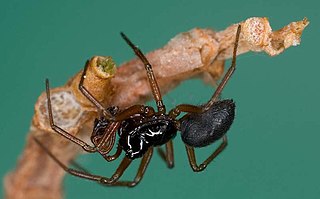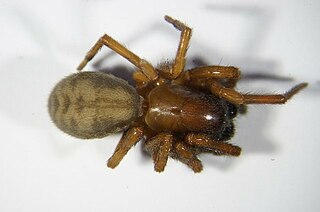
The little crow is an Australian species of crow, very similar to the Torresian crow in having white bases to the neck and head feathers but slightly smaller and with a slightly smaller bill. It has the same white iris that distinguish the Australian species from all other Corvus except a few island species to the north of Australia, and one from Eurasia, the jackdaw. Like the Australian raven, this species has a blue ring around the pupil.

Uloboridae is a family of non-venomous spiders, known as cribellate orb weavers or hackled orb weavers. Their lack of venom glands is a secondarily evolved trait. Instead, they wrap their prey thoroughly in silk, cover it in regurgitated digestive enzymes, and then ingest the liquified body.

Orb-weaver spiders are members of the spider family Araneidae. They are the most common group of builders of spiral wheel-shaped webs often found in gardens, fields and forest. "Orb" can in English mean "circular", hence the English name of the group. Araneids have eight similar eyes, hairy or spiny legs, and no stridulating organs.

Erigoninae are the largest subfamily of sheet weavers (Linyphiidae), which is itself the second largest spider family. In the United States they are known as dwarf spiders, while they are called money spiders in England. The exact taxonomic limits of the subfamily are not yet known.

The spider species Araneus diadematus is commonly called the European garden spider, diadem spider, orangie, cross spider and crowned orb weaver. It is sometimes called the pumpkin spider, although this name is also used for a different species, Araneus marmoreus. It is an orb-weaver spider found in Europe and North America.

The spider species Tegenaria domestica, commonly known as the barn funnel weaver in North America and the domestic house spider in Europe, is a member of the funnel-web family Agelenidae and a close relative of the hobo spider.

Buglife – The Invertebrate Conservation Trust is a British-based nature conservation charity.
Besnoitia bennetti is a parasite that can cause besnoitiosis infections in donkeys. The range of this organism ranges from Africa to the United States. B. bennettii shares similar characteristics with Toxoplasma, Neospora, and Sarcocystis genera. Lab work onB. bennetti is conducted at biosafety level 1.

The Casuariiformes is an order of large flightless birds that has four surviving members: the three species of cassowary, and the only remaining species of emu. They are divided into either a single family, Casuariidae, or more typically two, with the emu splitting off into its own family, Dromaiidae.

Nephila is a genus of araneomorph spiders noted for the impressive webs they weave. Nephila consists of numerous species found in warmer regions around the world. They are commonly called golden silk orb-weavers, golden orb-weavers, giant wood spiders, or banana spiders.

Araneus is a genus of common orb-weaving spiders. It includes about 650 species, among which are the European garden spider and the barn spider. The genus was erected by Carl Alexander Clerck in 1757.

Callobius claustrarius is a species of spider in the family Amaurobiidae. Males of the species reach 8 mm, females about 11 mm. Head and legs are reddish brown, the abdomen is dark grey with an extended brown surface, dotted with lighter brown specks.

Callobius is a genus of tangled nest spiders first described by R. V. Chamberlin in 1947.

Gasteracantha cancriformis is a species of orb-weaver spider. It is widely distributed in the New World.

Callobius severus is a species of spider found in parts of the United States and Canada. Individuals reach roughly 19 mm (3/4") in size, with males typically appearing smaller than females. Cephalothorax and legs are reddish to dark brown and the abdomen is dark to light grey with fine hairs, often appearing with large, bilaterally mirrored paler spots. Males feature large, extended palps with prominent projections.

Oxycomanthus bennetti, the Bennett's feather star, is a species of crinoid belonging to the family Comasteridae. It is found in shallow water in the Indo-Pacific between northern Australia and southeast Asia.
Nothophantes, the horrid ground-weaver, is a critically endangered monotypic genus of European dwarf spiders containing the single species, Nothophantes horridus. It was first described by P. Merrett & R. A. Stevens in 1995, and has only been found in an area of Plymouth smaller than 1 square kilometre (0.39 sq mi). The name comes from the Ancient Greek νόθος (nothos), meaning "spurious", and hyphantes, meaning "weaver". The species name comes from the Latin horridus, meaning "bristly".
Callobius nomeus is a species of hacklemesh weaver in the spider family Amaurobiidae. It is found in the United States and Canada.
Callobius pictus is a species of hacklemesh weaver in the spider family Amaurobiidae. It is found in the United States and Canada.














